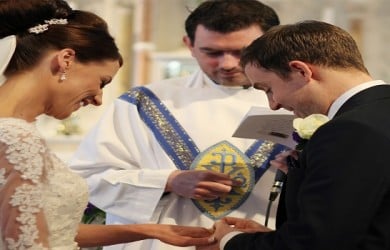A Guide to Catholic Marriage Vows

 Listen to this article
Listen to this article“What therefore God has joined together, let not man separate.” – Mark 10:9
Marriage is a sacred promise, but in a Catholic wedding, it’s more than just a personal commitment—it’s a covenant before God.
Catholic wedding vows are not just words spoken on a joyous day; they carry deep spiritual and lifelong significance.
But what exactly makes Catholic vows different? Can couples personalize them? And what role does the Church play in shaping these sacred promises?
If you’re preparing for a Catholic wedding or simply curious about its traditions, these are important questions to consider.
Unlike many modern weddings where couples experiment with their own vows, Catholic vows follow a time-honored script, emphasizing faith, unity, and commitment.
According to the Catechism of the Catholic Church, marriage is an unbreakable bond, and these vows reflect that belief.
This article will walk you through everything you need to know about Catholic vows—their meaning, tradition, and how they shape a lifelong union.
What do Catholic marriage vows truly mean?
Catholic wedding vows are more than just a ceremonial exchange of words—they are a lifelong commitment rooted in faith, love, and partnership.
These vows symbolize an unbreakable bond, a sacred promise made not just between two individuals but also before God and the Church.
But where do these vows come from, and why are they so central to Catholic marriage? Let’s explore their meaning in depth.
-
The origin and evolution of Catholic wedding vows
The practice of exchanging vows in a Catholic wedding dates back centuries, with roots in early Christian traditions. The structure of traditional Catholic wedding vows is based on Canon Law and the Church’s teachings, ensuring that marriage is recognized as a sacrament—a sacred act instituted by Christ.
Historically, Catholic marriage promises were formalized in the Middle Ages, when the Church established a standardized wedding rite.
According to the Catechism of the Catholic Church (CCC 1639-1640), marriage is an indissoluble union, meaning once the vows are spoken, the couple is bound together for life.
The wording of these vows has remained largely unchanged, emphasizing permanence, fidelity, and openness to children, reflecting the Church’s deep theological foundation.
Even today, couples recite the same vows used for generations:
“I take you to be my lawful wife/husband, to have and to hold, from this day forward, for better, for worse, for richer, for poorer, in sickness and in health, until death do us part.”
These words are not just tradition—they carry a profound commitment.
-
The spiritual and lifelong commitment behind the words
Unlike modern weddings where couples often write their own vows, traditional Catholic wedding vows focus on an eternal bond rather than personal sentiments. This is because, in Catholicism, marriage is not just about love—it’s about sacrificial love.
When couples recite their vows, they are making a covenant with God, meaning they are bound by divine law, not just legal agreements. This covenant reflects Christ’s love for the Church—unwavering, selfless, and enduring.
This lifelong commitment also means that challenges are expected, but the vows serve as a constant reminder that marriage is a journey of faith and perseverance.
Many Catholic couples find strength in knowing that their vows are not just promises to each other but also a spiritual bond that carries divine grace.
-
Why vows are central to a Catholic marriage
Catholic marriage promises are not just formalities; they are the foundation of the entire sacrament of marriage. Without these vows, the union would not be recognized by the Church. But why is this so important?
- They establish a sacramental bond: The vows are what make a marriage a sacrament, meaning they invite God into the relationship and offer His blessings for the couple’s journey.
- They are a public declaration of commitment: In Catholicism, marriage is a communal event. The vows, spoken before the priest and congregation, signify that this union is recognized by the Church and the faith community.
- They ensure the couple understands the responsibilities of marriage: The vows explicitly acknowledge that marriage involves both joy and hardship—”for better or worse”—preparing couples for the reality of lifelong partnership.
-
How Catholic vows reflect faith, love, and partnership
Catholic wedding vows are not just about romance; they are a reflection of divine love. The commitment within these vows mirrors Christ’s unconditional love for humanity, making them one of the most profound aspects of Catholic marriage.
- Faith: The vows require trust in God’s plan, reinforcing that marriage is a spiritual journey, not just a legal or emotional decision.
- Love: Unlike fleeting emotions, these vows represent agape love—a selfless, enduring love that prioritizes the well-being of one’s spouse.
- Partnership: Marriage in Catholicism is about mutual support. The vows emphasize the idea of standing together through all circumstances, whether joyful or difficult.
How are Catholic vows different from other wedding vows?
When couples exchange Catholic wedding vows, they are making more than just a promise to love and cherish each other—they are entering a sacred, lifelong covenant before God. But how do these vows differ from those in secular or other religious ceremonies?
Catholic vows follow a set structure that has remained largely unchanged for centuries. The words are simple yet deeply meaningful:
“I take you to be my lawful wife/husband, to have and to hold, from this day forward, for better, for worse, for richer, for poorer, in sickness and in health, until death do us part.”
Unlike in many modern weddings, couples do not write their own vows in a Catholic ceremony. This ensures that the commitment reflects Church teachings on marriage rather than personal preferences.
Unlike secular vows, Catholic wedding vows are not just emotional promises; they are a sacrament. This means they are spiritually binding and cannot be undone by personal choice alone. Divorce is not recognized in the Church, reinforcing the belief that marriage is a lifelong union.
- Secular weddings often allow couples to personalize their vows, focusing on love and companionship rather than religious commitment.
- Other religious vows may allow divorce or remarriage, while Catholic vows emphasize an unbreakable bond.
Can you write your own vows in a Catholic wedding?
If you’re dreaming of writing deeply personal vows for your wedding, you might wonder if it’s allowed in a Catholic wedding ceremony. The short answer? Not exactly—but that doesn’t mean your vows can’t feel personal and meaningful.
The Catholic Church requires couples to use traditional Catholic wedding vows during the ceremony. These vows are not just words of love but a formal declaration of marriage as a sacrament before God.
Because marriage is seen as a sacred, unchanging covenant, the Church does not permit couples to replace or rewrite these vows.
However, some priests allow minor additions before or after the official vows. For example, after reciting the required vows, a couple might share a short personal reflection or prayer. But this depends on the officiating priest and the diocese’s specific rules.
Even though you can’t alter the vows, you can still infuse your wedding with personal elements, such as:
- Writing heartfelt letters to exchange before the ceremony.
- Including personal prayers or readings that reflect your journey as a couple.
- Selecting music and scripture that hold deep meaning for both of you.
For example, a couple who overcame long-distance challenges might choose a Bible verse about perseverance in love, such as 1 Corinthians 13:4-7.
Marriage is much more than a single moment at the altar. You can express your commitment through:
- Personalized wedding toasts at the reception.
- A special blessing or promise during the ceremony.
- A handwritten note tucked into your spouse’s pocket as a surprise.
Need some help writing your own wedding vows? Wedding celebrant Benjamin Carlyle is here to give some ideas. Take a look:
What role do the priest and congregation play in Catholic vows?
A Catholic wedding is more than just a personal commitment between two people—it is a sacred union witnessed and blessed by the Church. The priest and congregation play essential roles in guiding, supporting, and affirming this lifelong promise.
-
The priest’s role in officiating and guiding the couple
In a Catholic wedding ceremony, the priest is not just a witness but a spiritual guide. His role includes:
- Preparing the couple for marriage through pre-marital counseling (Pre-Cana).
- Leading the ceremony, ensuring it follows Church teachings and traditions.
- Receiving the couple’s vows, as they exchange their sacred promises before God.
The priest does not marry the couple; instead, the bride and groom marry each other by reciting their vows. However, the priest acts as a representative of the Church, offering God’s blessing and ensuring the union is made in faith.
For example, during the ceremony, the priest may say: “Since it is your intention to enter the covenant of Holy Matrimony, join your right hands and declare your consent before God and His Church.” This highlights the spiritual weight of the moment.
-
How the congregation witnesses and supports the union
The congregation—family, friends, and fellow believers—serves as witnesses to the couple’s vows. In Catholic tradition, marriage is a public sacrament, meaning it must be recognized by the faith community.
Beyond simply watching, the congregation plays an active role by:
- Praying for the couple during the ceremony.
- Offering support and encouragement throughout their married life.
- Participating in hymns and readings, reinforcing the spiritual foundation of the union.
For example, in many Catholic weddings, the congregation responds with “We do” when the priest asks if they support the couple in their marriage. This moment symbolizes the couple’s commitment within a larger faith community.
-
The significance of community in a Catholic marriage
Marriage in the Catholic Church is never just about two individuals—it is about building a faithful and loving family within a larger community. The priest and congregation remind the couple that they are not alone; their love is part of God’s greater plan, supported by their church family every step of the way.
Conclusion: Beyond the vows
Saying “I do” in a Catholic wedding is just the beginning of a lifelong journey. The vows are powerful, but it’s the daily commitment to love, faith, and partnership that truly defines a Catholic marriage.
As you step into this sacred bond, remember that marriage is more than just words exchanged at the altar—it’s a promise to grow together, to support each other, and to keep God at the center of your union.
Lean on your faith, seek wisdom from your community, and cherish the love that brought you together. Whether you’re preparing for marriage or reflecting on your vows, always ask yourself: How can we strengthen our bond and keep our love rooted in faith?
Your journey as a couple doesn’t end with the wedding—it evolves every day. Keep nurturing it with love, patience, and grace, and let your marriage be a testament to the vows you made before God.
 Expert Q&A
Expert Q&A
Is there a phrase with "and obey" in catholic wedding vows?


Editorial Team
Relationship & Marriage Advice
Expert Answer
In traditional Catholic wedding vows, the phrase "to love, cherish, and to obey" is sometimes included, though it's not mandatory. The option to include it is offered in the official Order of Celebrating Matrimony. However, many modern couples choose to omit this phrase, opting for vows that emphasize mutuality and equality.
 Tips
Tips
Write your tip or submit a video tip
All tips are reviewed before the publishing.
Share this article on
Want to have a happier, healthier marriage?
If you feel disconnected or frustrated about the state of your marriage but want to avoid separation and/or divorce, the marriage.com course meant for married couples is an excellent resource to help you overcome the most challenging aspects of being married.

 Reviewed By
Reviewed By

 Thanks! We'll do our best to answer your question and post it above.
Thanks! We'll do our best to answer your question and post it above.























 We'd love your feedback!
We'd love your feedback!